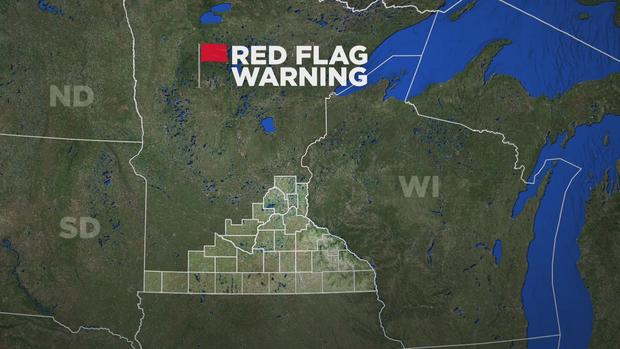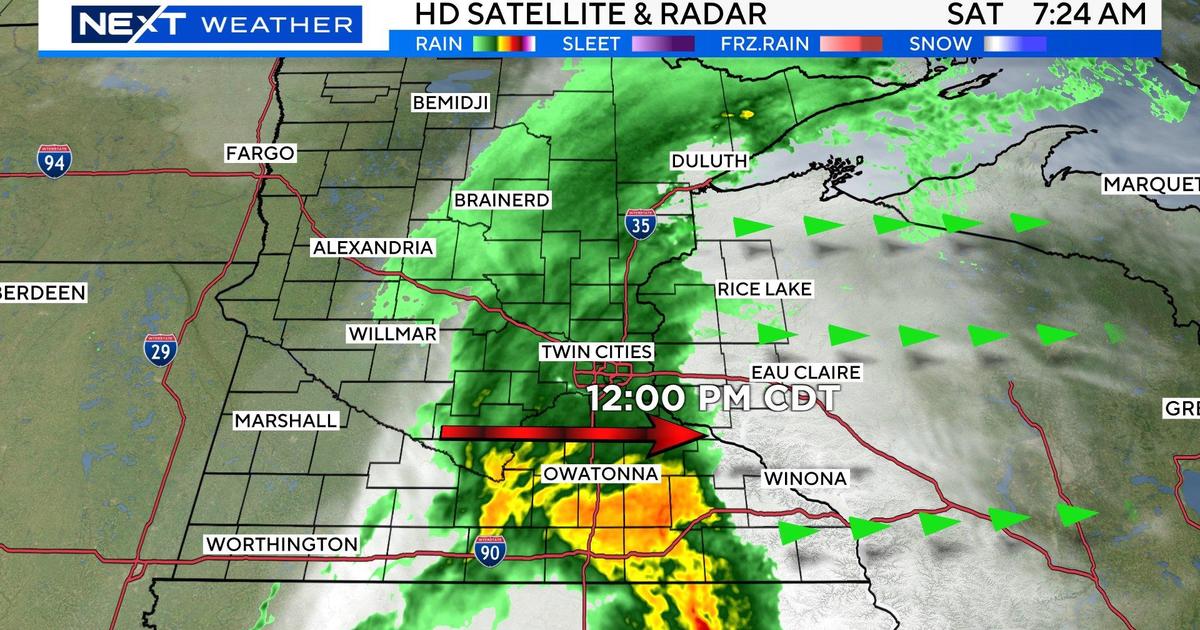Twin Cities, southern Minnesota under red flag warnings Thursday
MINNEAPOLIS -- Parts of southern and central Minnesota, including the Twin Cities, will be under red flag warnings on Thursday.
The National Weather Service has issued warnings for 31 counties, asking residents not to burn due to conditions ideal for spreading fires.
"Any kind of burning is a bad idea," Allissa Reynolds, wildfire prevention supervisor with the Minnesota Department of Natural Resources, said Thursday. "Campfires are allowed but they're discouraged. Any kind of debris burning, pile burning, things like that, they are prohibited today."
READ MORE: NEXT Weather: Twin Cities likely to hit another record high Thursday
The following counties are under a red flag warning starting at 11 a.m.: Anoka, Blue Earth, Brown, Carver, Cottonwood, Dakota, Faribault, Freeborn, Goodhue, Hennepin, Jackson, Le Sueur, Martin, Nicollet, Nobles, Ramsey, Rice, Rock, Scott, Sibley, Steele, Waseca, Washington and Watonwan.
A warning begins at noon for these counties: Dodge, Fillmore, Houston, Mower, Olmsted, Wabasha and Winona.
"We've had a number of fires in the state already, mostly in southern Minnesota as that snow recedes." said Reynolds.
A patch of weeds and grass caught fire in Minneapolis after neighbors say someone in a car drove by and threw a cigar or cigarette. They called 911 and by the time crews arrived to put the fire out, it spread an entire city block, charring the land between 8th and 9th streets off Van White Boulevard.
Reynolds says any kind of burning is a bad idea during red flag warnings. Though camp fires are allowed, they are discouraged, and burning piles are prohibited.
"I recommend you go back and check that, make sure it is absolutely out cold," said Reynolds. "Make sure there is no heat remaining. A lot of times those bigger logs and embers can hold heat for a long time."
All warnings are set to expire at 8 p.m.
What is a red flag warning?
Red flag warnings are issued when forecasts indicate that a combination of high temperatures, very low humidity and strong winds in a given location could create an environment that is conducive to dangerous fires, according to the National Weather Service. The agency sets these warnings most often between February 1 and April 30, and again from October 1 to December 15, when typical weather conditions are consistent with that criteria.
More specific criteria established by the National Weather Service, in coordination with government land management agencies, uses thresholds to determine whether a red flag warning should be issued, when it should be issued and for how long. The criteria considers fuel conditions — a parameter that refers to the amount of water held by "small vegetation," like grass, leaves and mulch, which indicates how the land could respond to either wet or dry environmental changes — when they have reached a critical point that could be favorable to the growth and spread of large fires, according to the agency.
Criteria also stipulates that a red flag warning is issued when relative humidity in an area drops to about 25% while surface winds or frequent gusts simultaneously climb to at least 25 miles per hour. Both conditions must occur simultaneously for at least three hours over a 12-hour period. Widely scattered, dry thunderstorms could trigger a red flag warning as well, with the National Weather Service deeming a thunderstorm "dry" if it produces less than 1/10 of an inch of rainfall.
Other environmental factors that contribute to a red flag warning include: lightning, when it is significant and occurs for the first time after a hot and dry period; dry cold fronts forecasted to cause strong and gusty winds and abrupt wind shifts, but little or no rainfall, especially in areas where there are ongoing wildfires or prescribed burns; and any weather and fuel conditions that could otherwise elevate the risks of fires when taken together, like unusually high temperatures and long-term drought. In California, for example, where massive and devastating wildfires are one consequence of a lengthy and severe drought in the American West, some experts have suggested that parts of the state are now experiencing a "wildfire season" that lasts year-round.




